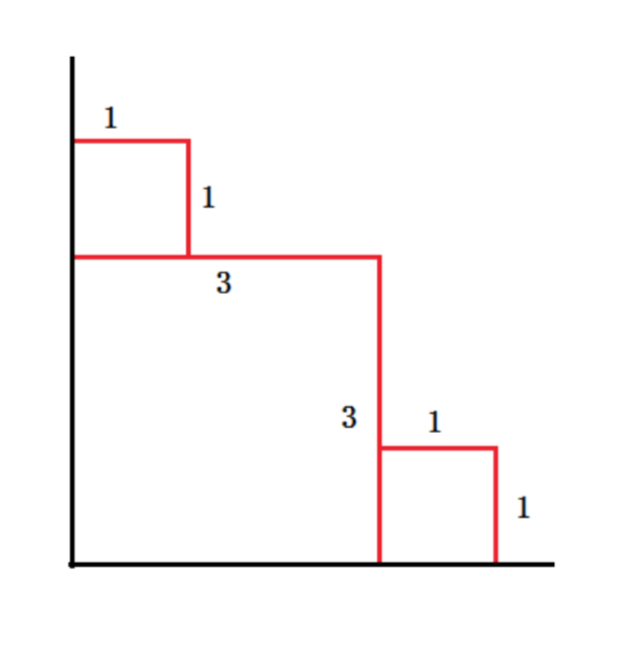描述
There’s a beach in the first quadrant. And from time to time, there are sea waves. A wave ( xx , yy ) means the wave is a rectangle whose vertexes are ( 00 , 00 ), ( xx , 00 ), ( 00 , yy ), ( xx , yy ). Every time the wave will wash out the trace of former wave in its range and remain its own trace of ( xx , 00 ) -> ( xx , yy ) and ( 00 , yy ) -> ( xx , yy ). Now the toad on the coast wants to know the total length of trace on the coast after n waves. It’s guaranteed that a wave will not cover the other completely.
Input
The first line is the number of waves n(n \le 50000)n(n≤50000).
The next nn lines,each contains two numbers xx yy ,( 0 < x0
Output
An Integer stands for the answer.
Hint:
As for the sample input, the answer is 3+3+1+1+1+1=103+3+1+1+1+1=10
样例输入
3
1 4
4 1
3 3样例输出
10题目来源
思路
题目定义了海的波浪是一个矩形,每一次给定一个坐标,波浪就会形成一个原点和当前点的矩形。一浪接着一浪,新的矩形就可能部分覆盖住原来的矩形,题目保证任意两个矩形都不相互覆盖,现在求在经过n次波浪之后,现在留下来的矩形的边长是多少。
因为题目保证了两个矩形一定不相互完全覆盖。我们知道新的波浪会覆盖以前的波浪,那么最后一个波浪一定没有被覆盖,是完整的矩形,所以我们先存一下每个波浪的坐标,然后倒着来。
用两个set来维护矩形的横坐标和纵坐标,首先把0插入到两个set之中,然后每一次查询比当前横纵坐标小的第一个值(可以先用set.lower_bound查出大于等于它的第一个数,然后迭代器–),由于题目保证了不相互覆盖,那么查到的横纵坐标的差的绝对值就可以累加到答案中,然后再把当前的横纵坐标插入.
累加完成后就是答案。
代码
#include <bits/stdc++.h>
using namespace std;
#define mem(a, b) memset(a, b, sizeof(a))
typedef long long ll;
typedef pair<int, int> pir;
const int N = 1e5 + 10;
struct node
{
int a, b;
} e[N];
set<int> sx, sy;
int main()
{
//freopen("in.txt", "r", stdin);
int n, a, b;
scanf("%d", &n);
for (int i = 1; i <= n; i++)
{
scanf("%d%d", &a, &b);
e[i].a = a, e[i].b = b;
}
sx.insert(0), sy.insert(0);
ll ans = 0;
for (int i = n; i >= 1; i--)
{
a = e[i].a, b = e[i].b;
auto it = sx.lower_bound(a);
--it;
ans += (a - *it);
sx.insert(a);
it = sy.lower_bound(b);
--it;
ans += (b - *it);
sy.insert(b);
}
printf("%lld\n", ans);
return 0;
}